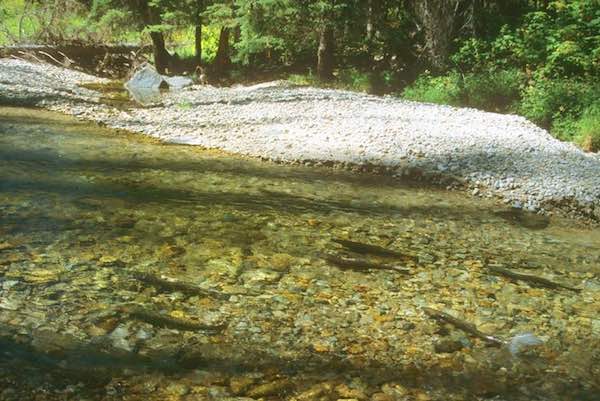forum
library
tutorial
contact

Middle Fork Boaters Urged to
Steer Clear of Salmon Redds
by StaffEast Idaho News, August 14, 2018
|
the film forum library tutorial contact |

|
Middle Fork Boaters Urged to
by Staff |
The number of salmon returning to the Middle Fork has been decreasing
since four federal dams were built on the Lower Snake River in the 1960s and 1970s.
 STANLEY -- Starting Wednesday, Aug. 15, all boaters on the Middle Fork of the Salmon River will be urged to steer clear of Chinook salmon spawning nests, known as redds, as they navigate the 100-mile-long National Wild and Scenic River in the Frank Church-River of No Return Wilderness.
STANLEY -- Starting Wednesday, Aug. 15, all boaters on the Middle Fork of the Salmon River will be urged to steer clear of Chinook salmon spawning nests, known as redds, as they navigate the 100-mile-long National Wild and Scenic River in the Frank Church-River of No Return Wilderness.
The Chinook spawning season on the main-stem Middle Fork occurs for a month, from August 15 -- September 15. The Middle Fork Ranger District will mark key salmon spawning areas so boaters know which areas to avoid.
The Middle Fork Outfitters Association (MFOA) has recruited volunteers to work at the Boundary Creek and Indian Creek launch sites to inform and educate outfitted and private float groups about the importance of steering around the spawning grounds as they float the river.
MFOA printed special "Do Not Disturb Chinook salmon spawning" waterproof boat tags that will be handed out to every boat captain on the Middle Fork.
"We are trying to assist the Forest Service to make sure that all Middle Fork float parties are aware that they need to up their game to avoid the redds," said Grant Simonds, government liaison for MFOA.
The Middle Fork supports a population of wild spring/summer Chinook salmon, which are listed as "threatened" under the Endangered Species Act. The number of salmon returning to the Middle Fork has been decreasing since four federal dams were built on the Lower Snake River in the 1960s and 1970s.
"The Middle Fork is in pristine condition, so the reason for the decline is totally a consequence of downriver impacts caused by the dams and reservoirs," says Tom Stuart, a Stanley-based board member of Idaho Rivers United, a statewide conservation group. "The salmon are in trouble. The importance of the wild fish on the Middle Fork cannot be overstated."
Last year, salmon dug just 11 redds on the main-stem Middle Fork. The number of redds varies from year to year.
Before the Lower Snake dams were built, Idaho Fish and Game counted 425 redds on the Middle Fork in 1951. Russ Thurow, a fisheries research scientist for the Forest Service at its Rocky Mountain Research Station in Boise, confirmed Stuart's comments about the crucial value of Middle Fork Chinook salmon. There are four key reasons why the fish are special and unique, Thurow said:
 The MFOA boat tags encourage float boat parties to stay at least 25 feet away from the redds. Orange "Redd Ahead" flagging on the Middle Fork will direct boaters to steer to the opposite side of the river channel, and red flagging will indicate they can return to normal boating operations.
The MFOA boat tags encourage float boat parties to stay at least 25 feet away from the redds. Orange "Redd Ahead" flagging on the Middle Fork will direct boaters to steer to the opposite side of the river channel, and red flagging will indicate they can return to normal boating operations.
"The Middle Fork of the Salmon River contains some of the best Chinook salmon habitat in the entire Columbia River Basin," said Dennis Kuhnel, Middle Fork District Ranger. "By working together to preserve these special fish, we can all ensure the beauty, diversity and splendor of the FC-RONR will continue for future generations to enjoy."
Chinook salmon also are highly revered by the Nez Perce and Shoshone-Bannock tribes in Idaho, being a "keystone" species, and an important part of the "circle of life," providing essential nutrients in spawning areas for a reported 137 species of birds, mammals, trees and plants.
By working to inform and educate float-boat parties about the importance of preserving Chinook salmon on the Middle Fork, outfitters want to show that boaters can co-exist with the fish during spawning season, and ensure that outfitted and private trips can continue during a critical period for the rural economy.
"Small rural economies like Stanley and Salmon can't afford to see the Aug. 15-Sept. 15 season go away," Simonds said.
A Must See Presentation
Chinook Salmon in pristine wilderness listed for ESA protection
by Russ Thurow, US Forest Service - Rocky Mountain Research Station, 2016
Related Pages:
Survival of Snake River Salmon & Steelhead Data compiled by bluefish.org, July 2004
Salmon Support 137 Other Species by Ed Hunt, Environment News Service, 7/6/00
learn more on topics covered in the film
see the video
read the script
learn the songs
discussion forum
